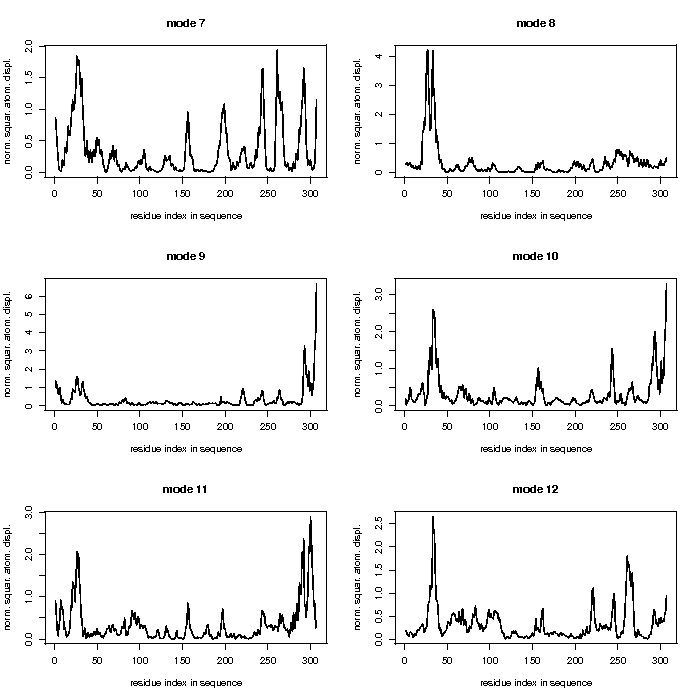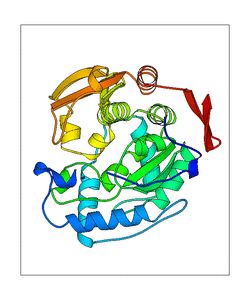Normal mode analysis (Phenylketonuria)
Page still under construction!!!
Contents
Summary
...
Normal Mode Analysis
Lab journal
For the analysis, we used the pdb structure 1J8U from the task before (Task 9 - Structure-based mutation analysis).
WEBnm@
<figure id="webMode">
</figure>
Mode 7
<figure id="web_mode7">
</figure>
This mode seems to have a high movement as the blue doted lines in <xr id="web_mode7"/> are relatively long. Furthermore they seem to open and close on all sites the same, which gives the imagine of a pump and not a twist. This also can be viewed in the first picture to the top left of <xr id="webMode"/>. Between residues 20 and 30 there is a high atomic displacement which also can be seen for residues 240 to 300.
Mode 8
<figure id="web_mode8">
</figure>
Mode 8 of WEBnm@ show a few differences to mode 7 as there seems only be a atomic displacement at residues 20 to 50 (<xr id="webMode"/> top right). In <xr id="web_mode8"/> you can see that this is represented in the picture on the right site of the binding site. Maybe this helps the protein to bind or release a substrate.
Mode 9
<figure id="web_mode9">
</figure>
Like in the mode before there is only a part of the protein showing a high atomic displacement. This part is between the residues 280 and 310 (<xr id="webMode"/>). However, there is also a small part in the beginning which shows atomic displacement of about 2 in the normalized value. Also you can see in <xr id="web_mode9"/> that there are two parts of the protein that have a high fluctuation, which is at the top of the picture and at the right. The vectors on the right seem to show a movement inside the protein.
Mode 10
<figure id="web_mode10">
</figure>
Mode 10 shows a high atomic displacement in some parts of the protein. Especially in the beginning before residue 50 and again after residue 280 (<xr id="webMode"/>). However, in <xr id="web_mode10"/> there seems to be not that high movements. ...
Mode 11
<figure id="web_mode11">
</figure>
This mode seems to have some similarities with mode 10 in the atomic displacement as there is a high atomic displacement in the beginning and in the end of the protein (<xr id="webMode"/>, bottom left). However, looking at <xr id="web_mode11"/> some differences can be viewed like in the bottom left of the picture, where you can see that the movement has another direction and may be indicate a small twist.
Mode 12
<figure id="web_mode12">
</figure>
The last mode provided by WEBnm@ here shows highest atomic displacement at residues 25 to 50 (<xr id="webMode"/>, bottom right). In <xr id="web_mode12"/> you can see ...
<figure id="correlation">
</figure>
elNémo
ElNémo computes models for the given protein 1J8U. Thereby it calculates 100 lowest-frequency modes and provides a lot of information about the modes with different parameters and visualizations:
- PDB-files with the conformations of the modes
- animations of the modes of three different sites
- CA-vari (calculates distance fluctuations between all C-alpha atoms)
- R2 residue mean square displacement of all C-alpha atoms
- Frequency and collectivity of the modes
<figtable id="frecol">
| First five modes | |||
|---|---|---|---|
| Mode | Frequency | Collectivity | |
| mode 7 | 1.00 | 0.5475 | |
| mode 8 | 1.02 | 0.4062 | |
| mode 9 | 1.36 | 0.2941 | |
| mode 10 | 1.43 | 0.0948 | |
| mode 11 | 1.60 | 0.3466 | |
</figtable>
- B-factor analysis for the correlation between observed and normal-mode-derived atomi displacement parameters:
- Correlation = 0.534 for 307 C-alpha atoms
- RMSD: only if two structures are used
Theoretical every number of normal mode perturbed models can be generated. However, a high number would take a lot of time. On default five normal modes will be computed by elNémo and can be increased up to 25. Additionally more normal modes can be calculated after the run. The analyses of the five modes with lowest frequency normal modes are shown below. For the calculation of the models all atoms are used.
Mode 7
<figure id="mode7_gif">
</figure>
<figure id="mode7_matrix">
</figure>
Like mode 7 of WEBnm@ this mode of elNémo seems to have a pumping movement or "breathing" (<xr id="mode7_gif"/>). In principal the whole protein seems to be part of the fluctuation including the β-strand shown in red. The matrix in <xr id="mode7_matrix"/> also shows both increasing and decreasing distances spread over the whole protein.
Mode 8
<figure id="mode8_gif">
</figure> <figure id="mode8_matrix">
</figure>
In <xr id="mode8_gif"/> you can see that the protein opens and closes at the binding site, whereby it looks like an opening and closing mouth. So this mode shows a hinge-movement for our protein PAH. The β-strand (red) does not move. Additionally in the correlation matrix (<xr id="mode8_matrix"/>) only small parts of the protein seem to move at all and the distances hardly ever increase, but decrease. In WEBnm@ a similar movement can be seen in mode 8 with just a few residues moving.
Mode 9
<figure id="mode9_gif">
</figure> <figure id="mode9_matrix">
</figure>
In this mode first you can see that the β-strand (red) moves a lot (<xr id="mode9_gif"/>). Like in mode 7 it looks like "breathing", just in a stronger way. In the matrix (<xr id="mode9_matrix"/>) you can see that the residues in the beginning seem to get higher distances to the other residues, whereas from residue 70 a smaller distance to the last 20 residues can be viewed. So with this two parts it has some similarities with mode 9 of WEBnm@.
Mode 10
<figure id="mode10_gif">
</figure> <figure id="mode10_matrix">
</figure>
Mode 10 (<xr id="mode10_gif"/>) has some similarities with mode 8 showing a hinge-movement. Also the β-strand on the right shows no fluctuation. <xr id="mode10_matrix"/> shows some movements on different parts of the protein. In comparison with the modes found with WEBnm@ this mode has some resemblances with both mode 10 and 11.
Mode 11
<figure id="mode11_gif">
</figure> <figure id="mode11_matrix">
</figure>
The fluctuation of mode 11 of PAH (<xr id="mode11_gif"/>) looks very similar to mode 9 (<xr id="mode9_gif"/>) with a "breathing" movement. Additionally the matrices have some resemblances. However, in this case (xr id="mode11_matrix"/>) there are more increasing distances and only at residue 180 the decreasing distance to the last 20 residues can be seen. This one seems to have no corresponding mode in WEBnm@.
References
<references/>

















